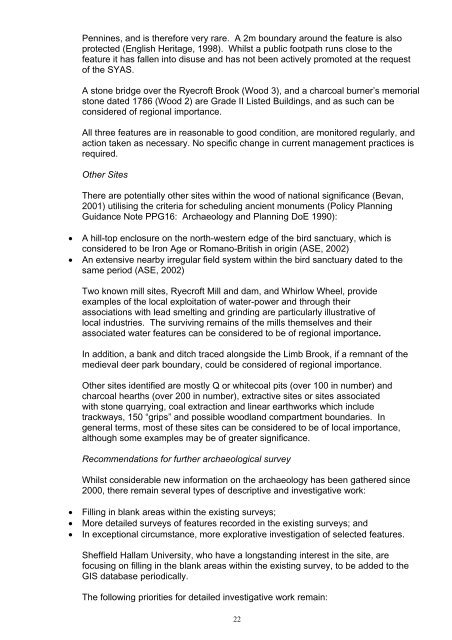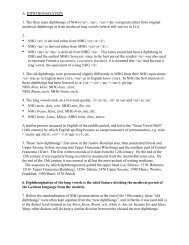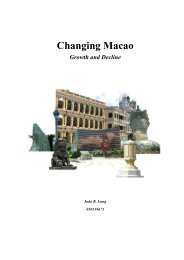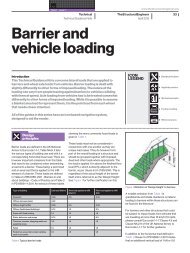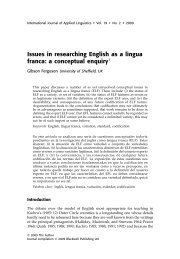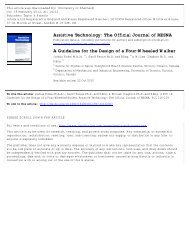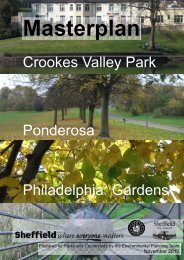eccelsall woods management plan.pdf - University of Sheffield
eccelsall woods management plan.pdf - University of Sheffield
eccelsall woods management plan.pdf - University of Sheffield
Create successful ePaper yourself
Turn your PDF publications into a flip-book with our unique Google optimized e-Paper software.
Pennines, and is therefore very rare. A 2m boundary around the feature is also<br />
protected (English Heritage, 1998). Whilst a public footpath runs close to the<br />
feature it has fallen into disuse and has not been actively promoted at the request<br />
<strong>of</strong> the SYAS.<br />
A stone bridge over the Ryecr<strong>of</strong>t Brook (Wood 3), and a charcoal burner’s memorial<br />
stone dated 1786 (Wood 2) are Grade II Listed Buildings, and as such can be<br />
considered <strong>of</strong> regional importance.<br />
All three features are in reasonable to good condition, are monitored regularly, and<br />
action taken as necessary. No specific change in current <strong>management</strong> practices is<br />
required.<br />
Other Sites<br />
There are potentially other sites within the wood <strong>of</strong> national significance (Bevan,<br />
2001) utilising the criteria for scheduling ancient monuments (Policy Planning<br />
Guidance Note PPG16: Archaeology and Planning DoE 1990):<br />
• A hill-top enclosure on the north-western edge <strong>of</strong> the bird sanctuary, which is<br />
considered to be Iron Age or Romano-British in origin (ASE, 2002)<br />
• An extensive nearby irregular field system within the bird sanctuary dated to the<br />
same period (ASE, 2002)<br />
Two known mill sites, Ryecr<strong>of</strong>t Mill and dam, and Whirlow Wheel, provide<br />
examples <strong>of</strong> the local exploitation <strong>of</strong> water-power and through their<br />
associations with lead smelting and grinding are particularly illustrative <strong>of</strong><br />
local industries. The surviving remains <strong>of</strong> the mills themselves and their<br />
associated water features can be considered to be <strong>of</strong> regional importance.<br />
In addition, a bank and ditch traced alongside the Limb Brook, if a remnant <strong>of</strong> the<br />
medieval deer park boundary, could be considered <strong>of</strong> regional importance.<br />
Other sites identified are mostly Q or whitecoal pits (over 100 in number) and<br />
charcoal hearths (over 200 in number), extractive sites or sites associated<br />
with stone quarrying, coal extraction and linear earthworks which include<br />
trackways, 150 “grips” and possible woodland compartment boundaries. In<br />
general terms, most <strong>of</strong> these sites can be considered to be <strong>of</strong> local importance,<br />
although some examples may be <strong>of</strong> greater significance.<br />
Recommendations for further archaeological survey<br />
Whilst considerable new information on the archaeology has been gathered since<br />
2000, there remain several types <strong>of</strong> descriptive and investigative work:<br />
• Filling in blank areas within the existing surveys;<br />
• More detailed surveys <strong>of</strong> features recorded in the existing surveys; and<br />
• In exceptional circumstance, more explorative investigation <strong>of</strong> selected features.<br />
<strong>Sheffield</strong> Hallam <strong>University</strong>, who have a longstanding interest in the site, are<br />
focusing on filling in the blank areas within the existing survey, to be added to the<br />
GIS database periodically.<br />
The following priorities for detailed investigative work remain:<br />
22


